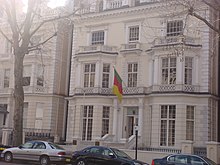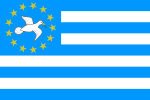Flag of Cameroon
| Flag of Cameroon | |
|---|---|
 |
|
| Vexillological symbol : |
|
| Aspect ratio: | 2: 3 |
| Officially accepted: | May 20, 1975 |
The flag of Cameroon was officially introduced on May 20, 1975.
Description and meaning
The model for the vertically divided national flag is the French tricolor . The pan-African colors are used : Green stands for hope and symbolizes the country's rich vegetation, which can be found mainly in the south. Yellow represents the sun and the savannah floor of the north. Red stands for the blood shed in the struggle for independence (“décolonisation”, “guerre du maquis”) and, in another interpretation, is a “symbol of sovereignty”. The golden star represents the union into a unique and indivisible state.
history
In the German colony of Cameroon (1884 to 1919) the imperial war flag was usually set. Only in the final years of German rule were there plans for the colony's own flag, but these were no longer implemented.
After the First World War , the colony was divided as a mandate between France and Great Britain. From then on, the French tricolor was used in the French part. It is possible that a Blue Ensign modeled on the British colonial flag was run in the British part . However, there is no reliable proof of its use.
On May 22, 1955, the Union des Populations du Cameroun adopted a black crab on a red background as its official flag in Yaoundé . Here reference is made to the origin of the country's name, although crabs and prawns were confused. The Portuguese sailors named the country Camarões after the shrimp they found there. The flag was discussed as the national flag for the future independent country, but the idea was dropped again when Western advisors feared that the country would make a fool of itself with this symbol.
On October 29, 1957, the then French part of Cameroon adopted Law 46, a tricolor based on the French model in the Pan-African colors, which forms the basis for today's flag. In the constitution of independent Cameroon of February 21, 1960 the flag was confirmed.
In 1961, the British area of South Cameroon decided to unite with the French-influenced Cameroon by referendum. This was the occasion on October 1st to include two yellow stars in the green stripe. They stood for the French and British cultures united in the country. After the establishment of the unified state in 1972, three years later the two stars became one that is now in the median.
 ? Draft for the German colony of Cameroon in 1914
? Draft for the German colony of Cameroon in 1914
 ? British Cameroon Flag, 1922 to 1961 (unsecured)
? British Cameroon Flag, 1922 to 1961 (unsecured)
 ? Flag of (French) Cameroon, 1957 to 1961
? Flag of (French) Cameroon, 1957 to 1961
 ? Flag of the United Cameroon, 1961 to 1975
? Flag of the United Cameroon, 1961 to 1975
More flags of Cameroon
The separatists, who are striving for independence in South Cameroon, wield a blue and white striped flag with a dove of peace and 12 gold stars in a circle in the jack .
The Bamileke live on the border with Nigeria on the eastern part of the delta of the Sananga River , both in the formerly British and in the formerly French part of Cameroon. Their national movement carried a flag with four horizontal stripes in green, yellow, red and black. It was created in the 1950s during the civil war in French Cameroon.
Flag of the separatists of South Cameroon
See also
Web links
- Flags of the World - Cameroon (English)







